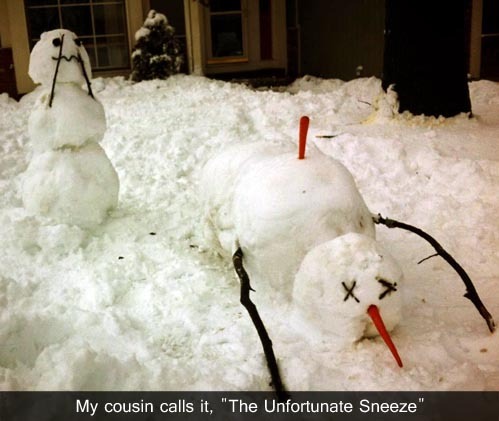There are some faults to be seen in this photo, and the "splort" mentioned yesterday is to the right middle edge. But what I want to draw attention to is the nature of sedimentation in the block to the left of the fault running diagonally from top right to bottom left. Starting from the bottom, overhanging, bit and working up, we first see some pretty well-sorted, finely stratified, fine-grained deposits. This would indicate a period of relative calm. Above that, a layer that is suddenly chaotic, poorly sorted, and much coarser overall. In addition, I'm seeing a suggestion of reverse grading, that is, it looks as if the clasts *may* be getting larger upwards- this would indicate an increasingly energetic environment. I'm very tentative on this point, though- it's just not as clear-cut as I'd like it to be. This coarser layer would indicate a burst in activity at the vent, creating a debris-laden wave, or surge, that was capable of carrying those large, cobbly clasts quite a distance- I don't think those are bombs. They're too angular and too abundant for that.
That paired sequence of fine (low energy)/coarse (high energy) then repeats three more times, and is capped with a final low energy interval, before switching to a period of moderate energy deposition. Lapilli-sized debris was consistently deposited, the finer material being overwhelmed by it, but the coarse large gravel to small cobbles are absent. Then a period of quiescence, followed by more of the moderate energy environment, a short period of peace, then more moderate energy, and we're off the top of the photo.
I don't really know enough to be totally confident in my interpretation here, but it seems logical enough- I'd love to hear from someone who knows more than I do about this kind of volcanoclastic sedimentation. Also, I'd caution that thickness is not equivalent to duration... it's difficult for me to make any guess about relative rates of deposition. I would have a hard time accepting the above sequence was deposited in less than days, nor that it took more than months, but that's simply a gut-level feeling, rather than based on any empirical evidence.
Whatever the reality of this spot is, I find it exhilarating to visit, find bunches of wonderful structures, and speculate wildly about just how they came to be. The esthetic appeal is pretty well up there for me, too.
Photo unmodified. August 20, 2011. FlashEarth Location.
Miscellaneous thoughts on politics, people, math, science and other cool (if sometimes frustrating) stuff from somewhere near my favorite coffee shop.
Saturday, March 9, 2013
Friday, March 8, 2013
Geo 365: March 8, Day 67: In the Neighborhood of the Splort
As I've been emphasizing the last couple weeks, there's a heck of a lot going on at Table Rock. There's plenty going on at Fort Rock, too, but the latter is well known, commonly if not heavily visited, while the former is largely unknown outside of a few intrepid, geologically-inclined, souls. And Table Rock records fine details, as well as a plethora of volcanoclastic sedimentary features, that Fort Rock simply does not. Table Rock deserves more attention, and this past couple week's photos have been my attempt to give it a bit of time in the spotlight.
Let's consider this environment as the eruption and deposition occured:
Photo unmodified. August 20, 2011. FlashEarth Location.
Let's consider this environment as the eruption and deposition occured:
- Sedimentation and erosion were both occurring quickly, as shown by poor sorting, angular grains, rapid changes in dominant grain sizes, and common disconformities.
- Overall, though, the pile was accumulating much faster than consolidation and lithification; it probably wasn't until long after the eruption stopped that much of the material could be considered to be "rock."
- During the episode, the pile of debris would be subject to frequent, likely locally powerful, seismic shock from two sources: earthquakes related to magma moving underground, and frequent phreatic blasts as ground and surface water interacted with hot basaltic magma and lava.
- I picture this situation as a rapidly growing "circular delta," with the central vent as the metaphorical sediment source. It seems likely that with such rapid accumulation, oversteepening and slumping were frequent. This would lead to tensional regimes in the topset beds, normal faulting in the foresets, and compression in the bottomsets. Because sedimentation was so rapid, the stress regime was almost certainly changing rapidly and constantly. This may have been exacerbated by rapid shifts from loading to unloading, and back, as sites of deposition became sites of erosion.
- Add on top of all this that the alteration of basalt to palagonite results in a net increase in volume. I'm not sure by how much, but in a pile like this, that effect probably shouldn't be ignored.
Photo unmodified. August 20, 2011. FlashEarth Location.
Thursday, March 7, 2013
Geo 365: March 7, Day 66: Hammer for Scale
Dana holds a hammer for scale over a set of normal faults forming a tight horst at Table Rock. Directly over the hammer, near the top of the photo, is a clast (actually two, the obvious one and another, smaller, to its right) that is much larger than anything around it. I suspect that was lobbed by an explosive blast at the actual vent, which would have been something like a mile and a half away.
Talk about nasty weather.
Photo unmodified. August 20, 2011. FlashEarth Location.
Talk about nasty weather.
Photo unmodified. August 20, 2011. FlashEarth Location.
Wednesday, March 6, 2013
Geo 365: March 6, Day 65: Palagonite Tuff
When a basaltic melt encounters water at or near the earth's surface, several things may happen: if the flow is gentle and gas poor, pillow basalt may form. Likewise, if the flow is under high confining pressure, such as an ocean ridge, under thousands of feet of water, that pressure prevents brecciation, and again pillows will form.
With lower pressures, though, and especially if the magma interacts with water below the surface, and erupts with a very high gas content, breccias of one type or another will form. In the case of Table Rock, the basalt was likely interacting with water in the ground, as well as erupting into a shallow lake. The basalt shattered and quenched upon eruption, but remained hot- at least warm- for some period of time. In these conditions, the very fine-grained or glassy volcanic rock altered quickly- you can think of it as accelerated weathering- to form the clay-like material, palagonite.
There are a large number of volcanic features around the Fort Rock-Christmas Lake Valley formed from water/lava interactions, and are largely composed of palagonite tuff such as that shown above. Fort Rock is the most famous, but none of the others I've seen have the variety that Table Rock does.
Photo unmodified. August 20, 2011. FlashEarth Location.
With lower pressures, though, and especially if the magma interacts with water below the surface, and erupts with a very high gas content, breccias of one type or another will form. In the case of Table Rock, the basalt was likely interacting with water in the ground, as well as erupting into a shallow lake. The basalt shattered and quenched upon eruption, but remained hot- at least warm- for some period of time. In these conditions, the very fine-grained or glassy volcanic rock altered quickly- you can think of it as accelerated weathering- to form the clay-like material, palagonite.
There are a large number of volcanic features around the Fort Rock-Christmas Lake Valley formed from water/lava interactions, and are largely composed of palagonite tuff such as that shown above. Fort Rock is the most famous, but none of the others I've seen have the variety that Table Rock does.
Photo unmodified. August 20, 2011. FlashEarth Location.
Tuesday, March 5, 2013
Geo 365: March 5 Day 64: Fault and Aerie
A fault runs through the cliff, offsetting the lighter buff sandstone in the lower portion of the exposure. Toward the top of the cliff, a splash of white and some sticks reveal the nest of some sort of raptor. It wasn't occupied at the time, so I have no idea what kind of bird it was. Raptors love this sort of cavernous weathering on cliff faces for nesting sites, but we would have been better off in the late spring to early summer to catch its inhabitants.
Photo unmodified. August 20, 2011. FlashEarth Location.
Photo unmodified. August 20, 2011. FlashEarth Location.
Monday, March 4, 2013
Geo 365: March 4, Day 63: Faulty Overhang
The last four photos in this series were taken looking at the fairly flat surface under the overhang visible above. The lighter-colored layer under the hammer's head is probably fine enough to be called sand, but it's marginal; the grain size is verging on lapilli. And, as you can see, just to the right of the hammer, a small fault offsets that layer by a few inches. The reason for that flat area I'd been looking at so closely for a few minutes is likely that it broke off from that small fault. Which, in turn, means that all that overhanging rock is likely to fall off itself, sometime in the not-too-distant future. Now the chances of that happening during the few minutes I was standing there were quite low, but the consequences would have been quite nasty, and easily fatal.
The moral? Pay attention to your surroundings!
Photo unmodified. August 20, 2011. FlashEarth Location.
The moral? Pay attention to your surroundings!
Photo unmodified. August 20, 2011. FlashEarth Location.
Sunday, March 3, 2013
Sunday Funnies: Mad World Edition
Cheezburger I may have already posted this, but I love it.
Walking From Work
Are You Talking to Meme?
"Before my defense." What Should We Call Grad School?
Historic LOL
Bits and Pieces
Tastefully Offensive
This would be Halloween perfection. Derpy Cats
Tastefully Offensive
"Riding in the back of the field trip van on an unpaved road driving to the outcrop." Geology is Hard
Wondermark
Cheezburger
Bits and Pieces
Sober in a Nightclub
Senor Gif "Gandalf Style"
Bits and Pieces
Mark Stivers
Bits and Pieces
Shirtoid, via Wil Wheaton's Tumblr. (Tees for sale at Shirt Woot! Only $15.)
Sofa Pizza
"Apex Predator" Tree Lobsters
Sober in a Nightclub
What Would Jack Do?
Blackadder
Jennifer Lawrence seems very cool, based on what I've read- granted, not a lot, but this is a good example of her type of comment. Wil Wheaton's Tumblr
The Far Left Side
STOP POKING ME! Senor Gif
Bits and Pieces
Criggo
Tastefully Offensive
Tastefully Offensive
Bits and Pieces
Lunar Baboon
"When my professor goes on and on about the importance of stromatolites" Geology is Hard
This cat doesn't even have the excuse it was cleaning its belly. It's back leg is just a dick. Sober in a Nightclub
"Hold me closer, tiny dancer." Senor Gif
Are You Talking to Meme?
Senor Gif
Geo 365: March 3, Day 62: Table Rock Rip-Up
A large rip-up (mud deposited and somewhat consolidated elsewhere, then ripped off the bottom, transported intact to a new location, then redeposited) and a few smaller ones at Table Rock. If you enlarge this, you can see the coarse, angular, and poorly-sorted nature of the sand grains in this deposit, which is fairly typical for sedimentary deposits at Table Rock. I don't know if anyone has ever done a detailed analysis and write-up of any significant portion of this volcanic/sedimentary pile, but there's a heck of a lot of detail to pay attention to. Apologies ahead of time, but I intend to spend yet another week looking at those details. We haven't even got to the "splort" yet.
Photo unmodified. August 20, 2011. FlashEarth Location.
Photo unmodified. August 20, 2011. FlashEarth Location.







































